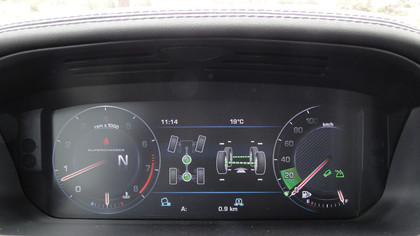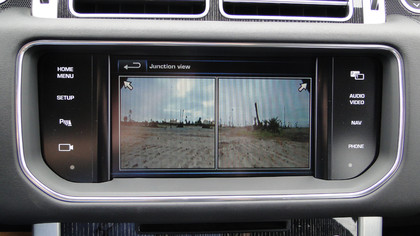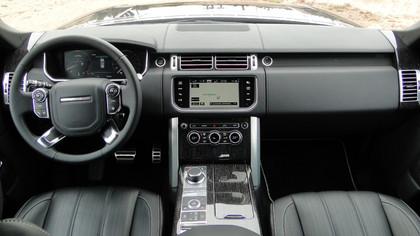New Range Rover packed to the grilles with futuristic features
LCD screens galore, lots of leather, unstoppable off-roading and more

Then there's the configurable mood lighting. A bit like a gaming PC, you can choose from a range of colours for the ambience lighting, natch.

Oh, and there's an optional rear seat entertainment pack that includes a pair of screens in the head rests and a rechargeable remote control with its own touchscreen. It's yours for £2,450. Yowch.

What you don't get, however, is anything by way of internet connectivity or smartphone syncing beyond the usual Bluetooth handsfree and address book access. Admittedly, in-car internet is still in its infancy. A long list of killer internet-connected in-car apps has yet to emerge.
But even today, things like HD traffic supplied over the internet are desirable. And they're conspicuously absent here.
Road trippin'
Vehicle dynamics and driver aids are probably the new Rangie's greatest technological strengths. Active roll control, adaptive cruise control, brake and park assist, blind spot monitoring, surround-view cameras, the new Range Rover has got the lot.
The cameras are particularly impressive - and useful on a vehicle so large. Multiple views are available to aid with everything from avoiding damage to those lovely alloys to getting a better look out of junctions.

On regular tarmac, the new Ranger Rover is much more responsive than before. Part of that is the lower weight. But the new Roll Stability Control system also contributes, dynamically controlling body lean and making for flatter cornering without ruining the ride.
Sign up for breaking news, reviews, opinion, top tech deals, and more.
The result is a large SUV that handles far better than you would possibly believe. It sounds ridiculous, but you can now have fun chucking a Range Rover through corners.
As ever, Land Rover's Terrain Response system makes an appearance. It's a kind of all-singing traction and stability control system optimised for off-road conditions. It now features an 'auto' mode which uses sensors to analyse driving conditions and chooses the best operating mode.

However, you can still switch manual between the various Grass/Gravel/Snow, Mud/Ruts, Sand, and Rock Crawl. You also get a digital display of exactly what the offroad hardware is up to on the new digital driver's instruments.
Mud-plugging masterpiece
Of course, the gadgets will only get you so far. So the new Range Rover has the full compliment of pukka off-road hardware.
That includes locking diffs front and rear and a two-speed transfer box that provides proper low ratios for off roading. The air suspension system also offers multiple modes and can increase ground clearence by up to 75mm.

Then there's the massive wheel travel (260mm front, 310mm rear), steep approach and departure angles and serious water wading ability of fully 900mm. The latter is enabled courtesy of a new air intake system that sucks air from a protected cavity between the inner and outer bonnet.
Anywho, the upshot of all this is bonafide offroad awesome. The pictures are real, folks. We really did drive a fleet of shiny new Range Rovers down a Morrocan river. And we did it all on standard road tyres.
Whether buyers of this plush new model are ever likely to emulate our launch-event escapades is a legitimate question. But there's no doubting the ability is there if called upon.

Performance and economy
You a choice of three engines on the new Range Rover. The family kicks off with the 258hp 3.9l V6 diesel model. The 4.4l V8 diesel with 339hp is the middle ranking model. And the 5.0l 510hp supercharged petrol V8 provides the plutocratic option.
Regarding CO2 and fuel consumption, you're looking at 196g/km and 37.7mpg, 229g/km and 32.5mpg and 322g/km and 20.5mpg respectively.

By any normal measure, either of the diesel models provides more than adequate performance, thanks in no small part to that massive reduction in kerb weight. Even the V6 model is pretty nippy, hitting 60mph in just 7.4 seconds.
But the petrol V8 is positively supernatural. Range Rover quotes 5.1 seconds to 60mph and if anything, it feels quicker than that. The acceleration is relentless.
TechRadar verdict
Depending on how you look at the new Range Rover, it's either beyond reproach or a decadent beyond belief.
For starters, the new model has a quite preposterous breadth of abilities. It's better than ever on road thanks to reduced mass and fancy chassis technology. And it's as unstoppable off road as any of the classic Rangies.

In terms of comfort and refinement, it's now near enough as dammit as good as the usual German suspects in the luxury saloon game. What's more, the extra rear cabin space has also elevated the new model to genuine luxury car status and made it a plausible proposition for chauffeur-driven duty.
And therein lies the problem. With prices starting at £69,995 for a poverty spec V6 model, the new Range Rover is operating in pretty rarefied territory. Go for the petrol V8 and chuck a few options at it and a six-figure price tag is eminently doable.

All of which makes the latest Range Rover a far cry from the Spartan original. But here's the thing, even at those prices, it feels like reasonable value. That's how good it is. That's how unique it feels in the market. If it wasn't for the infotainment functionality shortfall, it would be pretty much perfect.
Technology and cars. Increasingly the twain shall meet. Which is handy, because Jeremy (Twitter) is addicted to both. Long-time tech journalist, former editor of iCar magazine and incumbent car guru for T3 magazine, Jeremy reckons in-car technology is about to go thermonuclear. No, not exploding cars. That would be silly. And dangerous. But rather an explosive period of unprecedented innovation. Enjoy the ride.